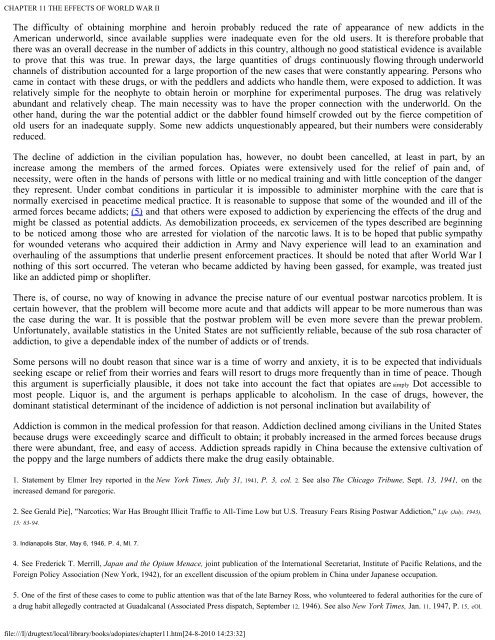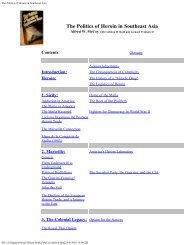Addiction and Opiates
Addiction and Opiates
Addiction and Opiates
You also want an ePaper? Increase the reach of your titles
YUMPU automatically turns print PDFs into web optimized ePapers that Google loves.
CHAPTER 11 THE EFFECTS OF WORLD WAR II<br />
The difficulty of obtaining morphine <strong>and</strong> heroin probably reduced the rate of appearance of new addicts in the<br />
American underworld, since available supplies were inadequate even for the old users. It is therefore probable that<br />
there was an overall decrease in the number of addicts in this country, although no good statistical evidence is available<br />
to prove that this was true. In prewar days, the large quantities of drugs continuously flowing through underworld<br />
channels of distribution accounted for a large proportion of the new cases that were constantly appearing. Persons who<br />
came in contact with these drugs, or with the peddlers <strong>and</strong> addicts who h<strong>and</strong>le them, were exposed to addiction. It was<br />
relatively simple for the neophyte to obtain heroin or morphine for experimental purposes. The drug was relatively<br />
abundant <strong>and</strong> relatively cheap. The main necessity was to have the proper connection with the underworld. On the<br />
other h<strong>and</strong>, during the war the potential addict or the dabbler found himself crowded out by the fierce competition of<br />
old users for an inadequate supply. Some new addicts unquestionably appeared, but their numbers were considerably<br />
reduced.<br />
The decline of addiction in the civilian population has, however, no doubt been cancelled, at least in part, by an<br />
increase among the members of the armed forces. <strong>Opiates</strong> were extensively used for the relief of pain <strong>and</strong>, of<br />
necessity, were often in the h<strong>and</strong>s of persons with little or no medical training <strong>and</strong> with little conception of the danger<br />
they represent. Under combat conditions in particular it is impossible to administer morphine with the care that is<br />
normally exercised in peacetime medical practice. It is reasonable to suppose that some of the wounded <strong>and</strong> ill of the<br />
armed forces became addicts; (5) <strong>and</strong> that others were exposed to addiction by experiencing the effects of the drug <strong>and</strong><br />
might be classed as potential addicts. As demobilization proceeds, ex servicemen of the types described are beginning<br />
to be noticed among those who are arrested for violation of the narcotic laws. It is to be hoped that public sympathy<br />
for wounded veterans who acquired their addiction in Army <strong>and</strong> Navy experience will lead to an examination <strong>and</strong><br />
overhauling of the assumptions that underlie present enforcement practices. It should be noted that after World War I<br />
nothing of this sort occurred. The veteran who became addicted by having been gassed, for example, was treated just<br />
like an addicted pimp or shoplifter.<br />
There is, of course, no way of knowing in advance the precise nature of our eventual postwar narcotics problem. It is<br />
certain however, that the problem will become more acute <strong>and</strong> that addicts will appear to be more numerous than was<br />
the case during the war. It is possible that the postwar problem will be even more severe than the prewar problem.<br />
Unfortunately, available statistics in the United States are not sufficiently reliable, because of the sub rosa character of<br />
addiction, to give a dependable index of the number of addicts or of trends.<br />
Some persons will no doubt reason that since war is a time of worry <strong>and</strong> anxiety, it is to be expected that individuals<br />
seeking escape or relief from their worries <strong>and</strong> fears will resort to drugs more frequently than in time of peace. Though<br />
this argument is superficially plausible, it does not take into account the fact that opiates are simply Dot accessible to<br />
most people. Liquor is, <strong>and</strong> the argument is perhaps applicable to alcoholism. In the case of drugs, however, the<br />
dominant statistical determinant of the incidence of addiction is not personal inclination but availability of<br />
<strong>Addiction</strong> is common in the medical profession for that reason. <strong>Addiction</strong> declined among civilians in the United States<br />
because drugs were exceedingly scarce <strong>and</strong> difficult to obtain; it probably increased in the armed forces because drugs<br />
there were abundant, free, <strong>and</strong> easy of access. <strong>Addiction</strong> spreads rapidly in China because the extensive cultivation of<br />
the poppy <strong>and</strong> the large numbers of addicts there make the drug easily obtainable.<br />
1. Statement by Elmer Irey reported in the New York Times, July 31, 1941, P. 3, col. 2. See also The Chicago Tribune, Sept. 13, 1941, on the<br />
increased dem<strong>and</strong> for paregoric.<br />
2. See Gerald Pie], "Narcotics; War Has Brought Illicit Traffic to All-Time Low but U.S. Treasury Fears Rising Postwar <strong>Addiction</strong>," Life (July, 1943),<br />
15: 83-94.<br />
3. Indianapolis Star, May 6, 1946, P. 4, MI. 7.<br />
4. See Frederick T. Merrill, Japan <strong>and</strong> the Opium Menace, joint publication of the International Secretariat, Institute of Pacific Relations, <strong>and</strong> the<br />
Foreign Policy Association (New York, 1942), for an excellent discussion of the opium problem in China under Japanese occupation.<br />
5. One of the first of these cases to come to public attention was that of the late Barney Ross, who volunteered to federal authorities for the cure of<br />
a drug habit allegedly contracted at Guadalcanal (Associated Press dispatch, September 12, 1946). See also New York Times, Jan. 11, 1947, P. 15, cOl.<br />
file:///I|/drugtext/local/library/books/adopiates/chapter11.htm[24-8-2010 14:23:32]





